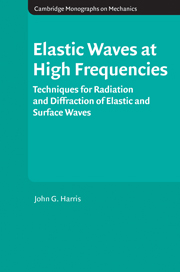Refine search
Actions for selected content:
8126 results in Fluid dynamics and solid mechanics
References
-
- Book:
- Turbulence and Shell Models
- Published online:
- 10 November 2010
- Print publication:
- 28 October 2010, pp 147-150
-
- Chapter
- Export citation
2 - 2D turbulence and the atmosphere
-
- Book:
- Turbulence and Shell Models
- Published online:
- 10 November 2010
- Print publication:
- 28 October 2010, pp 30-45
-
- Chapter
- Export citation
3 - Shell models
-
- Book:
- Turbulence and Shell Models
- Published online:
- 10 November 2010
- Print publication:
- 28 October 2010, pp 46-64
-
- Chapter
- Export citation
Preface
-
- Book:
- Turbulence and Shell Models
- Published online:
- 10 November 2010
- Print publication:
- 28 October 2010, pp ix-x
-
- Chapter
- Export citation
1 - Introduction to turbulence
-
- Book:
- Turbulence and Shell Models
- Published online:
- 10 November 2010
- Print publication:
- 28 October 2010, pp 1-29
-
- Chapter
- Export citation
Contents
-
- Book:
- Turbulence and Shell Models
- Published online:
- 10 November 2010
- Print publication:
- 28 October 2010, pp v-viii
-
- Chapter
- Export citation
5 - Chaotic dynamics
-
- Book:
- Turbulence and Shell Models
- Published online:
- 10 November 2010
- Print publication:
- 28 October 2010, pp 74-94
-
- Chapter
- Export citation
Index
-
- Book:
- Turbulence and Shell Models
- Published online:
- 10 November 2010
- Print publication:
- 28 October 2010, pp 151-152
-
- Chapter
- Export citation
7 - Intermittency
-
- Book:
- Turbulence and Shell Models
- Published online:
- 10 November 2010
- Print publication:
- 28 October 2010, pp 110-120
-
- Chapter
- Export citation
8 - Equilibrium statistical mechanics
-
- Book:
- Turbulence and Shell Models
- Published online:
- 10 November 2010
- Print publication:
- 28 October 2010, pp 121-134
-
- Chapter
- Export citation
ANALYSIS OF THE INEXACT UZAWA ALGORITHMS FOR NONLINEAR SADDLE-POINT PROBLEMS
- Part of
-
- Journal:
- The ANZIAM Journal / Volume 51 / Issue 3 / January 2010
- Published online by Cambridge University Press:
- 21 October 2010, pp. 369-382
-
- Article
-
- You have access
- Export citation
A NOTE ON THE NUMERICAL APPROACH FOR THE REACTION–DIFFUSION PROBLEM WITH A FREE BOUNDARY CONDITION
- Part of
-
- Journal:
- The ANZIAM Journal / Volume 51 / Issue 3 / January 2010
- Published online by Cambridge University Press:
- 13 October 2010, pp. 317-330
-
- Article
-
- You have access
- Export citation

Elastic Waves at High Frequencies
- Techniques for Radiation and Diffraction of Elastic and Surface Waves
-
- Published online:
- 05 October 2010
- Print publication:
- 22 July 2010
OPTIMAL CONTROL PROBLEMS FOR GENERAL GLOBAL HYBRID DYNAMICAL SYSTEMS WITH MATRIX COST FUNCTIONAL
- Part of
-
- Journal:
- The ANZIAM Journal / Volume 51 / Issue 3 / January 2010
- Published online by Cambridge University Press:
- 04 October 2010, pp. 331-349
-
- Article
-
- You have access
- Export citation
A NOTE ON PERIODIC SOLUTIONS OF A FORCED LIÉNARD-TYPE EQUATION
- Part of
-
- Journal:
- The ANZIAM Journal / Volume 51 / Issue 3 / January 2010
- Published online by Cambridge University Press:
- 27 September 2010, pp. 350-368
-
- Article
-
- You have access
- Export citation

Gravity–Capillary Free-Surface Flows
-
- Published online:
- 07 September 2010
- Print publication:
- 15 July 2010
6 - Wave propagation and spectra
-
- Book:
- Internal Gravity Waves
- Published online:
- 05 October 2014
- Print publication:
- 02 September 2010, pp 315-356
-
- Chapter
- Export citation
Preface
-
- Book:
- Internal Gravity Waves
- Published online:
- 05 October 2014
- Print publication:
- 02 September 2010, pp xiii-xvi
-
- Chapter
- Export citation
5 - Generation mechanisms
-
- Book:
- Internal Gravity Waves
- Published online:
- 05 October 2014
- Print publication:
- 02 September 2010, pp 262-314
-
- Chapter
- Export citation
1 - Stratified fluids and waves
-
- Book:
- Internal Gravity Waves
- Published online:
- 05 October 2014
- Print publication:
- 02 September 2010, pp 1-73
-
- Chapter
- Export citation
